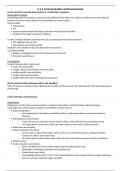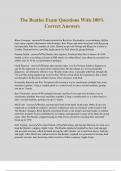Resume
OCR Biology A level Module 5 detailed summary notes
- Cours
- Établissement
This is a very detailed summary notes of 57 pages for OCR Biology A Module 5, including all the topics (Communication and homeostasis, Excretion, Neuronal communication, Hormonal communication, Animal and plant responses, Photosynthesis, and Respiration). It includes diagrams and photographs to ass...
[Montrer plus]





